We Finally Know Why Rotisserie Chicken Tastes So Good
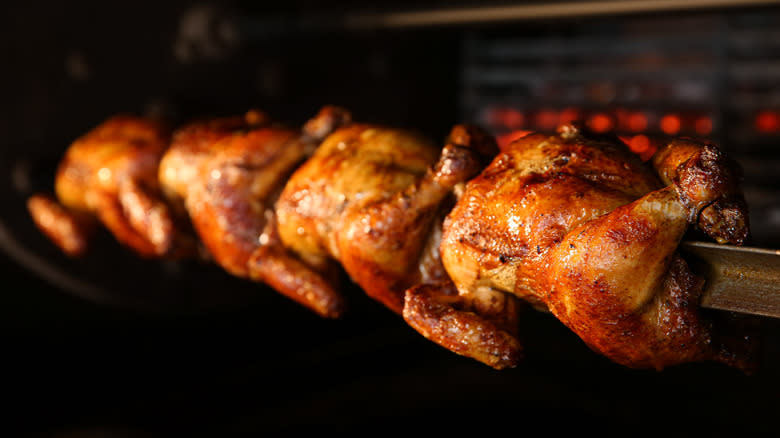
Chicken is the most popular meat in the United States. The Hustle estimated that an average American consumed 99 pounds of it during 2022; that's more than the average American's consumption of both beef and fish combined. While chicken is popular in many forms, few have gained as much acclaim as rotisserie chickens.
A key part of the rotisserie chicken's appeal is its taste. Almost without fail, they boast succulent, caramelized, and moreish meat that has the added benefit of being pre-packaged and ready for consumption. Thanks to this, rotisserie chickens have been popular around the world for centuries, and in the U.S. since the late 20th and early 21st centuries.
Costco produces the most popular rotisserie chicken of all American brands. In 2017, it was estimated that the brand's rotisserie chicken accounted for nearly one in every seven chickens served in the U.S. A key facet of this popularity is the product's low price, which has remained at $4.99 for many years. In order to compete, other brands have followed suit, and, as a result, rotisserie chickens in the U.S. are now expected to be both delicious and great value for money. But if very little money is being spent on preparing them, why do these rotisserie chickens taste so good?
Read more: 15 Tricks For Making The Most Crispy Chicken Thighs Ever
The Chickens Baste One Another
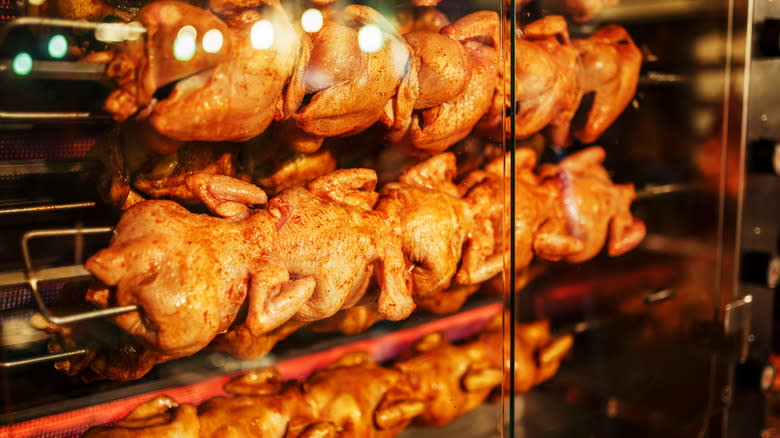
Unless they are made at home, rotisserie chickens are rarely cooked by themselves. On the contrary, most stores feature large rotisserie machines that cook multiple birds per spit. Usually, several spits rotate around one another within this rotisserie cooker, although there are some models that simply stack the spits atop one another. Regardless of which rotisserie machine is used, many birds are cooked in close proximity to one another. Aside from looking appetizing, this results in one major benefit: the liquified fat from those chickens cooking at the top of the machine drips onto those below.
This transfer of fat can be viewed as a kind of hands-off basting, the results of which speak for themselves. Thanks to the fat, the chickens develop a fantastically intense flavor. Basting also prevents the meat from drying out and is a key factor in developing the rotisserie chicken's trademark brown hue. Traditionally cooked chicken, especially those that sit alone in the oven, are not privy to such basting and, as a result, carry a significantly lesser taste.
The Skin Is Sticky
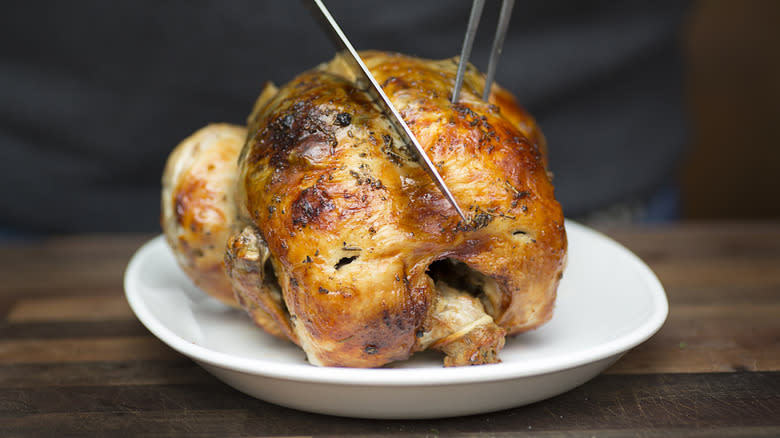
When roasting chickens, most cooks aim for crisp skin that emits an audible crunch during eating. This is not the case for most rotisserie chickens which flaunt a moreish, sticky skin that is somehow even more enticing.
Sticky chicken skin is a hallmark of rotisserie chickens far and wide, including those cooked in both huge grocery stores and tiny roadside stalls. Although it might not be crisp, this skin is richly caramelized in a manner that can't be replicated by other cooking processes. Kip Kolow, who pioneered the introduction of rotisserie chicken to the United States, said as much in a conversation with Taste: "Rotisserie chicken has a different caramelization, different moisture content, and you'll never have better skin."
While the skin's flavor is developed during cooking, its unique texture is obtained afterward when the chicken sits in its packaging pre-sale. During this time, the condensation that forms inside the packaging softens the once-crisp skin giving it the soft, sticky texture beloved by all rotisserie chicken connoisseurs. Those who crave crisp skin need not worry. The skin can easily be crisped at home either by reheating the whole bird in the oven or removing the skin and cooking it in an air fryer.
They Often Contain A Lot Of Salt

Many people know that salt is a flavor enhancer. Fewer are aware that different concentrations of salt have widely varying effects on a dish's flavors. At high concentrations, salt greatly enhances the experience of umami. Consequently, large amounts of salt are often added to savory food products and commercially prepared rotisserie chickens are no different. For example, a three-ounce serving of Costco's famous rotisserie contains 460 milligrams of salt. This is a large amount of salt that could be deemed excessive. In terms of flavor, however, its impact is indisputable.
Home cooks usually add salt by sprinkling it over a cooking chicken but food companies do it quite differently, adding it via injection. This process is known as plumping and involves saline solution being pumped deep into the animal's tissue through multiple injections. This saline solution distributes the salt evenly throughout the carcass. Thanks to the presence of binding agents, this solution stays within the meat during cooking, ultimately making for a more flavorful chicken.
The Meat Is Juicy
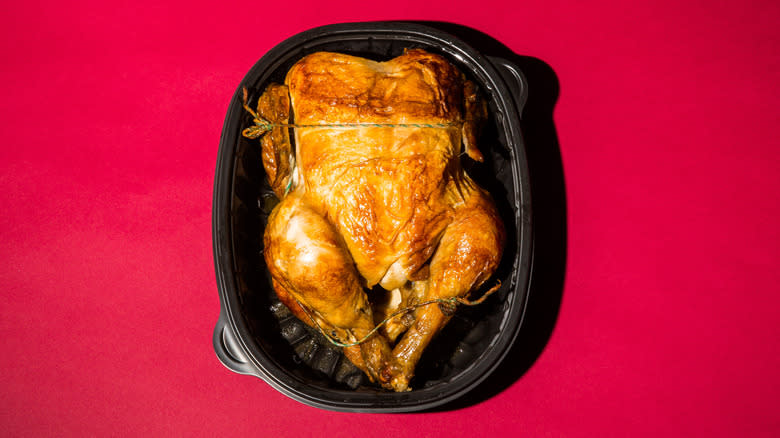
Aside from adding flavor, the saline solution that's injected into the chicken's tissue also ensures that the bird remains juicy. This is not only due to the addition of extra water but also additives including phosphate. These additives help the meat absorb and retain moisture before, during, and after the cooking process. As a result, every mouthful of the meat retains a succulent texture. It is important to note, however, that the National Kidney Foundation states a diet high in phosphates can have multiple negative health implications including increasing the risk of heart attack.
Injecting chicken carcasses with phosphate is extremely common as Tom Super, senior vice president of communications for the National Chicken Council explained to Consumer Reports: "Essentially, all rotisserie chickens are enhanced with a solution [injected into the bird] to keep the birds moist and tasty." This means most popular grocery store brands, including Costco, use some form of phosphate in their rotisserie chickens. People should keep this in mind when deciding whether to eat the succulent product with regularity.
The Chickens Are Reared To Suit American Palates
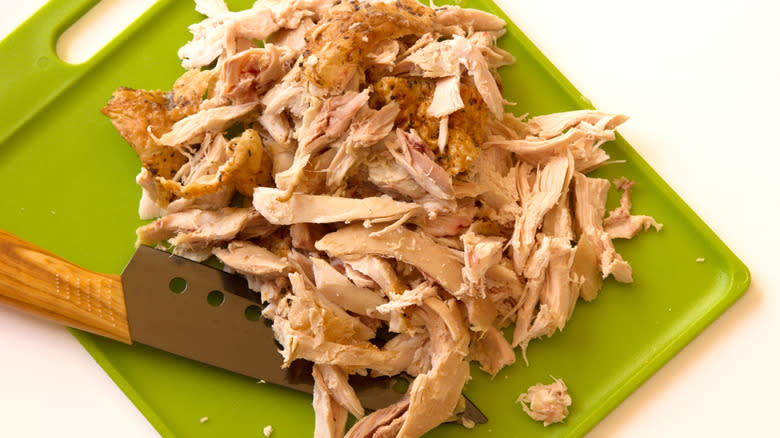
It is no mistake that American rotisserie chickens are loved by the American public; it's by design. Since the Second World War, chickens in the United States have been bred for size, speed of growth, and the efficiency with which they can transform feed into meat. A side effect of the focus on these measures has been a significant loss of flavor.
Over the decades, Americans have grown accustomed to chicken's diminishing flavor. Today, chicken meat is expected to be tasteless as acclaimed journalist Maryn McKenna highlighted in a conversation with Taste: "When we say something tastes like chicken, we really mean it doesn't taste like anything. In America, it's a bland, white protein, but that's not true for other parts of the world." As nearly all rotisserie chickens come from stock that has been reared to be bland, the American public receives what they expect: an inoffensive, mild piece of meat.
When it comes to rotisserie chicken, the animal's blandness also ensures marinades, additives, and seasonings account for the product's flavor. Again, this suits the average American palate which, through the regular consumption of ultra-processed food, has come to favor foods dominated by large quantities of additives like salt and sugar.
The Meat Is Cooked Evenly
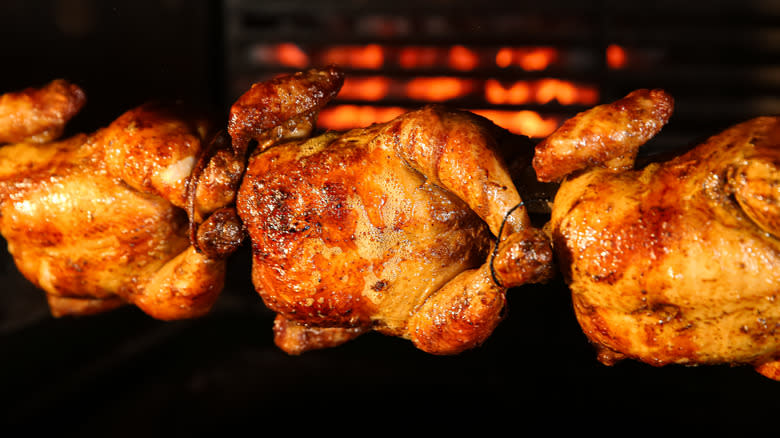
Cooking a chicken at home often involves direct applications of heat which result in the meat being exposed to uneven temperatures. Even chickens that are cooked in ambient heat settings -- for example, roasting in the oven -- suffer the same fate because the majority of home ovens fail to distribute heat evenly. Ultimately, this leads to some parts of the chicken becoming over or undercooked. In either case, the eating experience is not a pleasant one.
Uneven cooking is not an issue for rotisserie chickens; the heating elements in large-scale rotisseries are arranged in a way so all the rotating chickens receive an equal amount of heat. Because of this, all the meat is cooked to perfection. What's more, the entirety of the chicken's surface area is also browned. When it comes to eating, this cooking process ensures that every mouthful of rotisserie chicken is tasty, succulent, and tender. More than can be said for a lot of chicken that's cooked via different methods.
It's Nostalgic
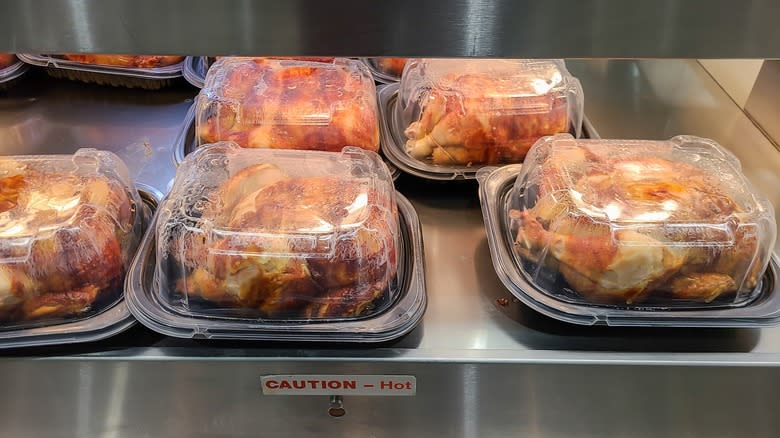
In the United States, rotisserie chickens became widely available during the 1990s. The first company to popularize them was Boston Chicken. Other brands, like Costco and Kroger, soon followed suit. By the early 2000s millions of Americans were sampling rotisserie chickens. Many of these individuals were children at the time and have since grown up. As a result, rotisserie chicken has become, for some of these individuals at least, a nostalgic food item that brings to mind memories of childhood.
When it comes to food, nostalgia is a powerful thing. It makes the food, in this case, a rotisserie chicken, symbolic of another meaning, for example, family. This in turn transforms the chicken into a food that's more comforting and enjoyable as was explained to Time Magazine by professor of psychology Jordan Troisi: "Comfort food seems to be something people associate very significantly with close relationships. This probably comes about by individuals coming to associate a particular food item with members of their family, social gatherings, and people taking care of them."
Those who grew up eating rotisserie chicken, and developed positive associations with it, continue to buy it today. What's more, these individuals tend to overlook the product's shortcomings -- such as dry breast meat -- and thus believe the product to be extremely tasty.
The Chickens Are On The Smaller Side
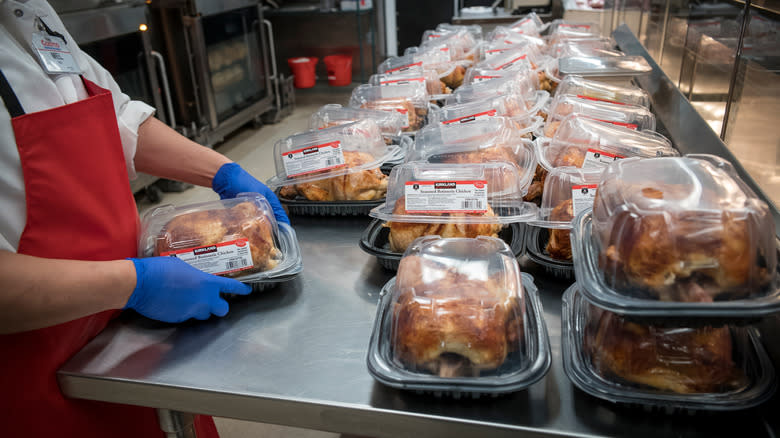
Chickens raised in the United States have been getting progressively bigger since the mid-20th century; between the 1940s and early 2000s, the average American broiler chicken went from weighing 2.2 pounds to 8.8 pounds. Although larger chickens are prized throughout the American food chain, companies producing rotisserie chickens prefer to use smaller birds.
The birds destined for the rotisserie are usually slaughtered when weighing between 2.5 to 4.5 pounds. This weight is attained at less than 10 weeks old. The reason for butchering the chickens so young is simple: smaller birds are more tender and less flavorful than older, larger chickens. As we have seen, tenderness and blandness are two characteristics Americans look for when purchasing commercially produced rotisserie chickens.
Consumers willing to try larger rotisserie chickens are not likely to have the opportunity because American rotisserie chickens prepared on a commercial scale must have similar proportions. If chickens of varying sizes were used, cooking times would have to be changed lest the larger chickens not cook sufficiently. Ultimately, this is too much hassle for rotisserie chicken producers meaning American consumers will continue to be sold small, tender, and mild-tasting chickens.
Read the original article on Daily Meal.

